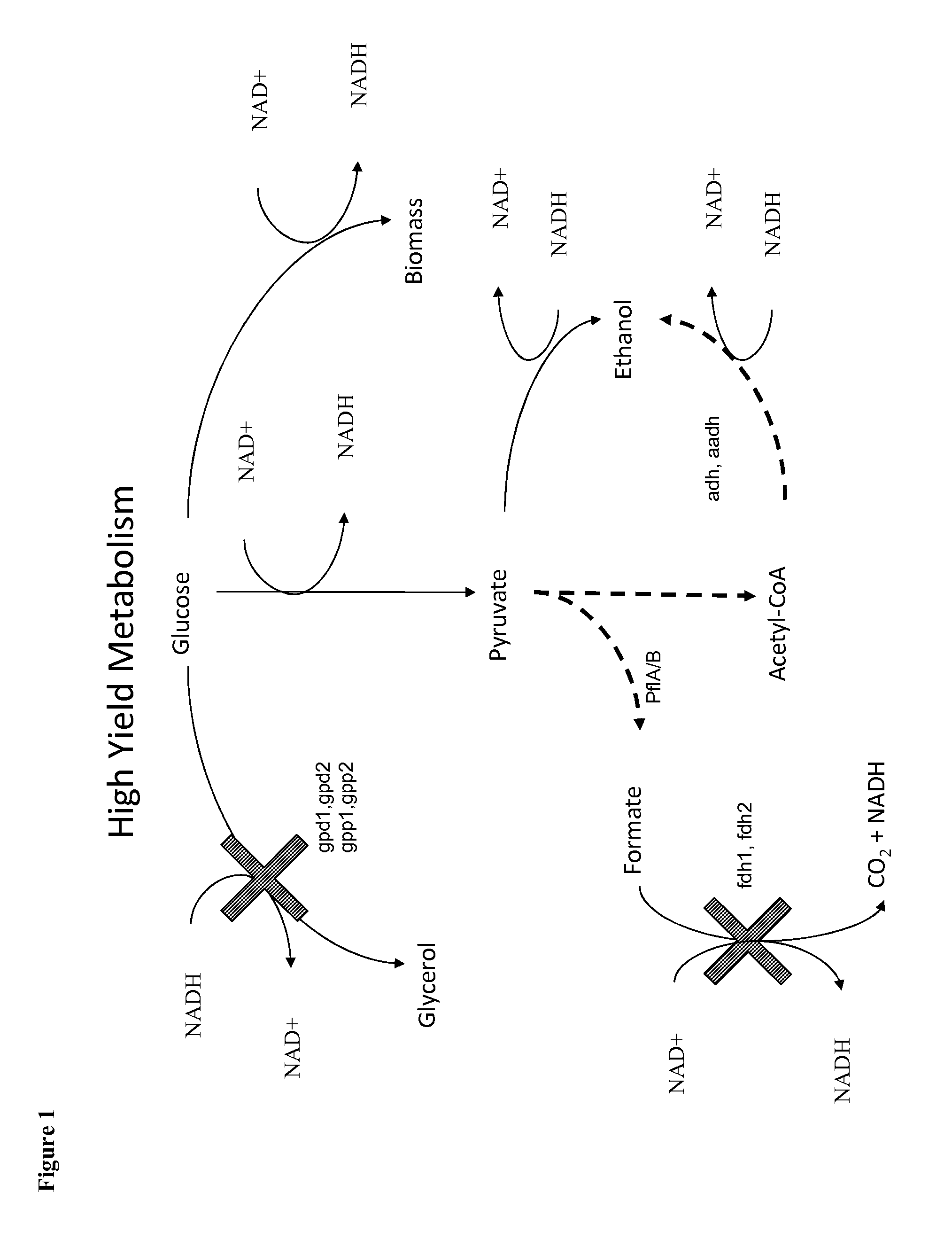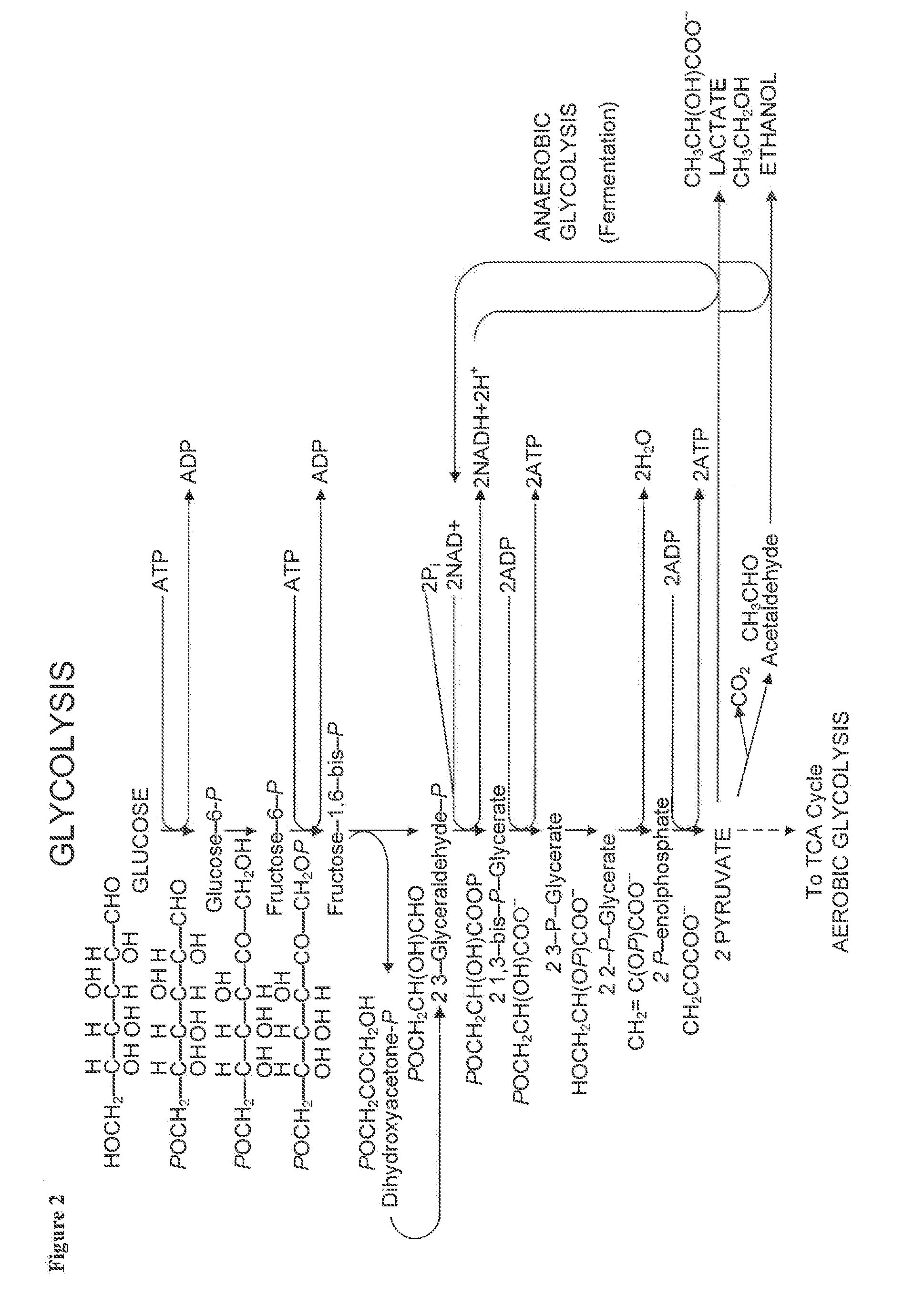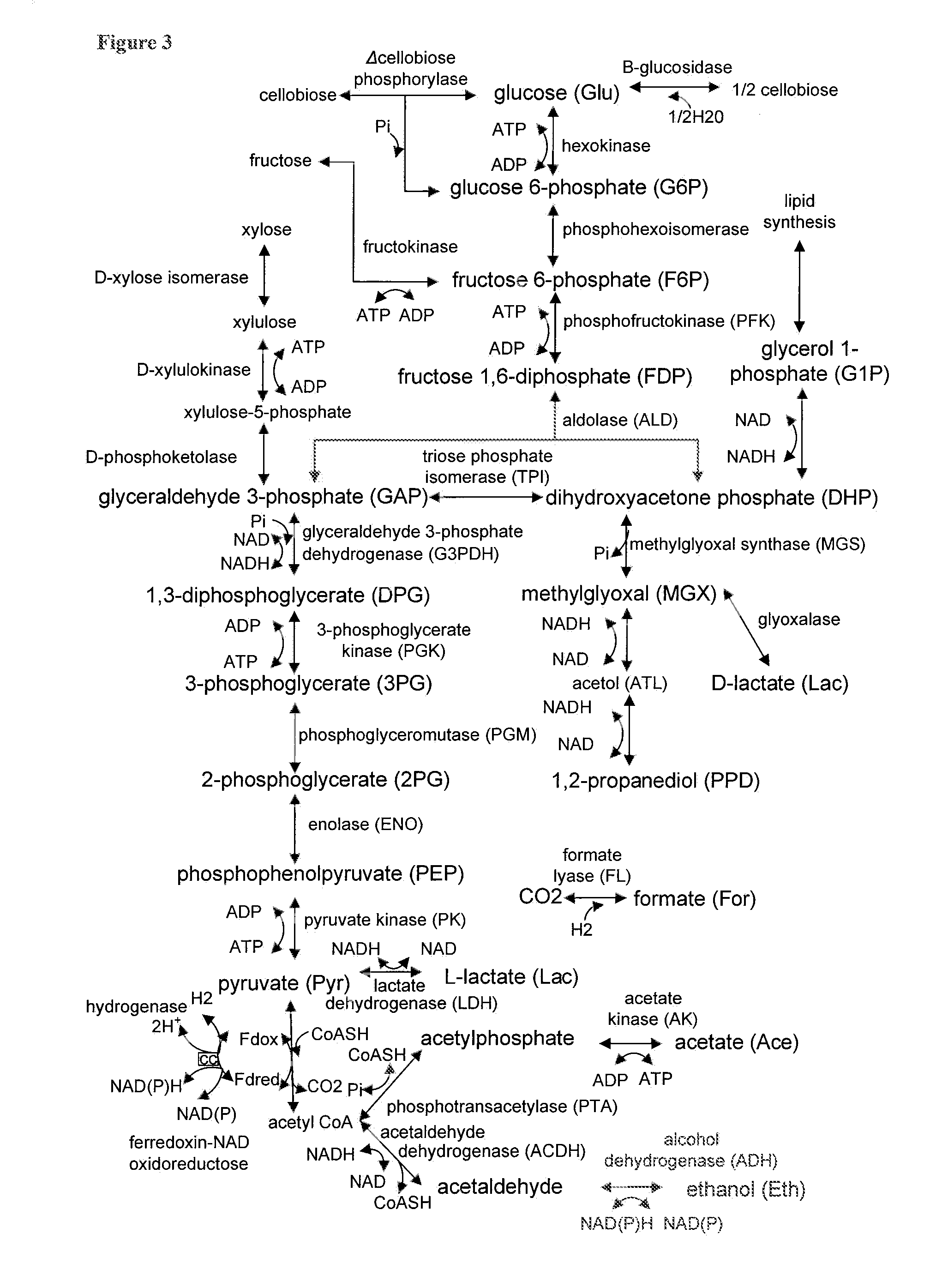Methods for the Improvement of Product Yield and Production in a Microorganism Through the Addition of Alternate Electron Acceptors
a technology of product yield and product production, which is applied in the field of methods for improving product yield and production in a microorganism through the addition of alternate electron acceptors, can solve the problems of anaerobic growth of yeast, relatively little has been demonstrated for the removal or reduction of glycerol, and the improvement of overall sugar yield to ethanol or other desired end-products of metabolism, etc., and achieves the effect of reducing glycerol formation
- Summary
- Abstract
- Description
- Claims
- Application Information
AI Technical Summary
Benefits of technology
Problems solved by technology
Method used
Image
Examples
example 1
Improving Ethanol Yield Through Engineering of Alternate Electron Acceptors
[0354]The present Example describes pathways to reduce or eliminate glycerol by engineering alternate electron acceptors in a yeast cell. Glycerol is an undesired by-product of sugar metabolism during anaerobic growth in yeast. The amount of glycerol produced during anaeroblic growth on glucose has been empirically determined by Medina, V G, et al., Appl. Env. Microbiol. 76:190-95 (2010):
56 mmol glucose→1 g biomass+88 mmol ethanol+95 mmol CO2+11 mmol glycerol+1.7 mmol acetate
[0355]Assuming glycerol production is primarily for the regeneration of NAD+ for the continuation of glycolysis, a half reaction for glycerol production is (Medina, V G, et al., Appl. Env. Microbiol. 76:190-95 (2010)):
0.5 glucose+NADH+H++ATP→glycerol+NAD+ADP+Pi
[0356]The following pathways describe engineering an alternate electron acceptor for glycerol in the above half reaction, engineering an increase in ethanol yield during anaerobic ...
example 2
Deletion or Downregulation of Glycerol-Regulating Gene FPS 1 to Improve Ethanol Yield
[0370]Instead of, or in addition to, downregulating glycerol production through deletion or alteration of glycerol-forming genes, glycerol production can be downregulated by deletion or alteration of a glycerol-regulating gene. FPS1 is an aquaglyceroporin responsible for efflux of glycerol. An fps1Δ strain has reduced glycerol formation yet has a completely functional NAD+-dependant glycerol synthesis pathway. In addition to deletion of FPS1, constitutively active mutants of FPS1 or homologs from other organisms can be expressed to alter glycerol production. Because such FPS1 deletion or alteration strains can still synthesize and retain glycerol, improved robustness may be observed relative to strains that are unable to make glycerol.
[0371]Null mutants of an fps1Δ strain grow much slower anaerobically than wild-type due to intracellular glycerol accumulation. Tamás, M. J., et al., Molecular Microbi...
example 3
Generating Yeast Strains with a Deleted or Downregulated Glycerol-Production Pathway
[0374]To create yeast strains with altered glycerol production, endogenous glycerol-producing or regulating genes can either be deleted or downregulated, by generating the following genetic backgrounds:
Haploid StrainsDiploid StrainsGlycerolgpd1Δ gpd2Δ fdh1Δ fdh2Δgpd1Δ / gpd1Δ gpd2Δ / gpd2ΔEliminationfdh1Δ fdh2Δ fps1Δfdh1Δ / fdh1Δ fdh2Δ / fdh2ΔBackgroundgpd1Δ gpd2Δ fdh1Δ fdh2Δfdh1Δ / fdh1Δ fdh2Δ / fdh2Δfps1Δfps1Δ / fps1Δgpd1Δ gpd2Δ fps1Δgpd1Δ / gpd1Δ gpd2Δ / gpd2Δgpd1Δ gpd2Δfdh1Δ / fdh1Δ fdh2Δ / fdh2Δfps1Δ / fps1Δgpd1Δ / gpd1Δ gpd2Δ / gpd2Δfps1Δ / fps1Δgpd1Δ / gpd1Δ gpd2Δ / gpd2ΔGlycerolgpd1Δ gpd2Δ::GPD1 fdh1Δgpd1Δ / gpd1ΔReductionfdh2Δgpd2Δ / gpd2Δ::GPD1 / GPD1Backgroundgpd1Δ gpd2Δ::GPD1fdh1Δ / fdh1Δ fdh2Δ / fdh2Δgpd1Δ gpd2Δ::GPD1gpd1Δ / gpd1Δfdh1Δfdh2Δ fps1Δgpd2Δ / gpd2Δ::GPD1 / GPD1gpd1Δ gpd2Δ::GPD1 fps1Δgpd1Δ / gpd1Δgpd1Δ: GPD2 gpd2Δgpd2Δ / gpd2Δ::GPD1 / GPD1GPD1::GPD2 gpd2Δfdh1Δ / fdh1Δ fdh2Δ / fdh2Δfdh1Δfdh2Δfps1Δ / fps1Δgpd1Δ / gpd1Δgpd2Δ / gpd2Δ::GPD1 / GPD1fp...
PUM
| Property | Measurement | Unit |
|---|---|---|
| temperature | aaaaa | aaaaa |
| temperature | aaaaa | aaaaa |
| temperature | aaaaa | aaaaa |
Abstract
Description
Claims
Application Information
 Login to View More
Login to View More - R&D
- Intellectual Property
- Life Sciences
- Materials
- Tech Scout
- Unparalleled Data Quality
- Higher Quality Content
- 60% Fewer Hallucinations
Browse by: Latest US Patents, China's latest patents, Technical Efficacy Thesaurus, Application Domain, Technology Topic, Popular Technical Reports.
© 2025 PatSnap. All rights reserved.Legal|Privacy policy|Modern Slavery Act Transparency Statement|Sitemap|About US| Contact US: help@patsnap.com



